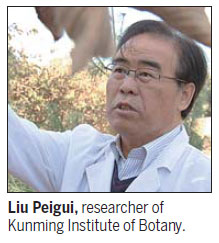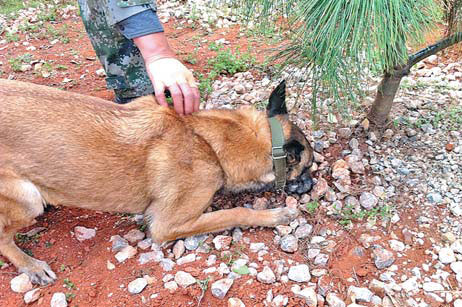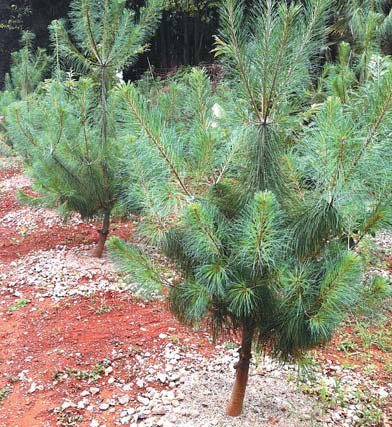Black diamonds
Updated: 2013-05-01 13:41
By Guo Anfei (China Daily)
|
|||||||||
|
A dog is trained to find the truffles under the host pine saplings. Guo Anfei / China Daily |
|
The 3-year-old Yunnan pine saplings are host trees for black truffles. Guo Anfei / China Daily |

Chinese truffles have been so popular in the last decade that natural reserves are now seriously threatened. The light on the horizon is a research farm that has successfully cultivated these precious fungi. Guo Anfei reports from Kunming.
Yunnan province has produced its first batch of cultivated black truffles, and experts say they hope the fungi will be available on the commercial market a few years later.
Researchers at the Kunming Institute of Botany under the auspices of the Chinese Academy of Sciences have worked on the plantation since 2001, and their efforts finally paid off late last year when they harvested their first truffles.
"Because of the high market demand, people have picked the wild fungus carelessly, depleting natural reserves to levels that are dangerously near extinction," says Liu Peigui, researcher, Kunming Institute of Botany.
He is the main motivator behind the project, and has dedicated much of the last 12 years to the research of truffle cultivation.
Currently, the institute has 33 hectares of black truffles cultivated in Yunnan. Each hectare can produce 300 to 450 kg of black Chinese truffles per year when the plantation is matured.
In China, truffles are found in the wild mainly in Sichuan and Yunnan.
Truffle plantations first started in Spain, France and Italy, and now, the United Kingdom, Germany, Finland, Sweden, Canada, United States, New Zealand and Australia also cultivate the valuable fungi.
"Chinese black truffle yields are low. They grow slowly, and are very exacting in terms of natural conditions," Liu says. Over-harvesting has caused the natural occurrence of truffles to distinctly drop, and in recent years, they have become increasingly rare.
Zhou Zhongping, the chairman of Chuxiong Honggui Green Food Co Ltd, is a major supplier of the natural fungus. He says Yunnan's wild truffle resources have been severely strained since 2000.
Indiscriminate picking of truffles before they have matured is one of several reasons why.
Truffles that can grow up to 300 to 500 grams are being picked when they are only 10 to 20 grams. Foragers dig up the truffles carelessly, damaging the underground mycelia or root systems that will produce truffles in the following year.
While the truffles should only be harvested from November to February at their peak, eager pickers are harvesting them as early as September, or August, or even earlier in June or July.
Zhou's company produces and exports environmentally friendly food from Yunnan, a province that produces more than half of the world's wild mushroom varieties. Two-thirds of China's mushrooms are found here.
In the poorer agricultural regions in the north, truffle and other wild edible mushroom harvesting has become a major source of income. The export of wild fungus has become a mainstay of Yunnan's economic development and the province plans to produce 360,000 tons of edible fungus by 2015, with a turnover of 10 billion yuan ($1.61 billion).
"Black truffles prefer more alkaline soil. In China, there are vast karst landform and limestone areas suitable for truffle plantation. When there is acid rain, and with industrial development, their growth is adversely affected," says researcher Liu.
Liu says China has discovered 29 species of truffles so far, while there are more than 100 known varieties in the world that can be roughly divided into high, middle and low grades.
The best quality truffles are the French black truffle and Italian white truffle. However, Chinese black truffle and summer truffle are related to the French black truffle and European summer truffle respectively. Liu believes there may be a truffle in China that is similar to the Italian white truffle.
Cultivated truffles taste no different from those that grow in the wild, Liu says, and they can be harvested about 40 to 50 years after planting.
After that, if properly protected and with careful management, they can still produce an annual crop every winter.
Truffles have more than 100 aromatic elements, and are rare, delicious and nutritious - which is why they are so expensive.
"Even though truffles can now be cultivated, their prices will not come down significantly. As people can afford more luxury, the demand will grow rapidly. What was available only to the elite is now available to many more," Liu says.
Under the research program by the Institute of Botany, every hectare of cultivated truffles can yield about 300 to 450 kg, and at the current prices of 1,500 to 2,000 yuan per kilogram, each hectare of land will bring in about 450,000 to 900,000 yuan.
Truffle planting can also be a lucrative source of income for local farmers in the regions suitable for truffle growth.
While Italy and France are already famous for their truffles, Yunnan in China has only just started supplying restaurants with these "black diamonds".
Truffles have been known in China a long time, and locals in the truffle producing regions called it the "pig-snout fungus" because sows forage for them in the ground.
Besides Yunnan and Sichuan, the Kunming Institute of Botany has also started truffle mycorrhizal plantation tests in Xinjiang, Inner Mongolia, Ningxia, Jiangxi, Zhejiang and Beijing, using different host trees and truffle strains.
"Truffles can be cultivated on barren limestone mountain slopes and it can help the re-forestation process, preventing soil erosion and water loss," Liu says.
Black truffles are exacting about the type of trees, climate and soil they grow in. Liu says the truffles prefer Yunnan pine, Huashan pine, Chinese chestnut, hazel and oak.
They also prefer an altitude of 1,000 to 2,800 meters above sea level where the soil is rich in limestone and calcium, and slightly alkaline - most of these conditions being found in Southwest China.
"The most difficult parts of our research and experiment was the truffle ectomycorrhizal synthesizing, such as truffle inoculation, mycorrhizae detection, transplanting and careful management. These steps may sound easy, but they were very challenging in reality," Liu says.
Choosing the right trees to grow the truffles was the first difficulty.
Liu's team needed to find the right base culture for the infection of the fungus. After planting, the team had to ensure the inoculation had the proper pH value, temperature, the right amount of water and sunlight.
Pollution must be monitored or it can kill the fragile microcosms during the synthesizing process. And after the culture takes root, proper maintenance must be observed, including pest prevention, weed control, watering, and pruning of the trees to allow the truffles the optimum conditions to grow.
Liu says the Kunming Institute of Botany is the first to cultivate black truffles in China. The truffles are expected to be commercially available in about four years' time.
Contact the writer at guoanfei@chinadaily.com.cn.
Ye Jun contributed to the story.
(China Daily 04/28/2013 page1)

 Michelle lays roses at site along Berlin Wall
Michelle lays roses at site along Berlin Wall
 Historic space lecture in Tiangong-1 commences
Historic space lecture in Tiangong-1 commences
 'Sopranos' Star James Gandolfini dead at 51
'Sopranos' Star James Gandolfini dead at 51
 UN: Number of refugees hits 18-year high
UN: Number of refugees hits 18-year high
 Slide: Jet exercises from aircraft carrier
Slide: Jet exercises from aircraft carrier
 Talks establish fishery hotline
Talks establish fishery hotline
 Foreign buyers eye Chinese drones
Foreign buyers eye Chinese drones
 UN chief hails China's peacekeepers
UN chief hails China's peacekeepers
Most Viewed
Editor's Picks

|

|

|

|

|

|
Today's Top News
Shenzhou X astronaut gives lecture today
US told to reassess duties on Chinese paper
Chinese seek greater share of satellite market
Russia rejects Obama's nuke cut proposal
US immigration bill sees Senate breakthrough
Brazilian cities revoke fare hikes
Moody's warns on China's local govt debt
Air quality in major cities drops in May
US Weekly

|

|










